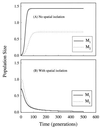Spatial and resource factors influencing high microbial diversity in soil
- PMID: 11772642
- PMCID: PMC126564
- DOI: 10.1128/AEM.68.1.326-334.2002
Spatial and resource factors influencing high microbial diversity in soil
Abstract
To begin defining the key determinants that drive microbial community structure in soil, we examined 29 soil samples from four geographically distinct locations taken from the surface, vadose zone, and saturated subsurface using a small-subunit rRNA-based cloning approach. While microbial communities in low-carbon, saturated, subsurface soils showed dominance, microbial communities in low-carbon surface soils showed remarkably uniform distributions, and all species were equally abundant. Two diversity indices, the reciprocal of Simpson's index (1/D) and the log series index, effectively distinguished between the dominant and uniform diversity patterns. For example, the uniform profiles characteristic of the surface communities had diversity index values that were 2 to 3 orders of magnitude greater than those for the high-dominance, saturated, subsurface communities. In a site richer in organic carbon, microbial communities consistently exhibited the uniform distribution pattern regardless of soil water content and depth. The uniform distribution implies that competition does not shape the structure of these microbial communities. Theoretical studies based on mathematical modeling suggested that spatial isolation could limit competition in surface soils, thereby supporting the high diversity and a uniform community structure. Carbon resource heterogeneity may explain the uniform diversity patterns observed in the high-carbon samples even in the saturated zone. Very high levels of chromium contamination (e.g., >20%) in the high-organic-matter soils did not greatly reduce the diversity. Understanding mechanisms that may control community structure, such as spatial isolation, has important implications for preservation of biodiversity, management of microbial communities for bioremediation, biocontrol of root diseases, and improved soil fertility.
Figures





References
Publication types
MeSH terms
Substances
LinkOut - more resources
Full Text Sources

